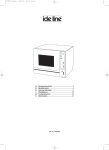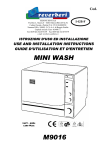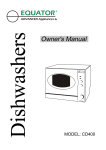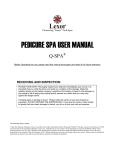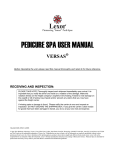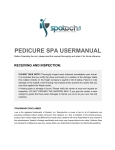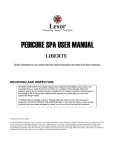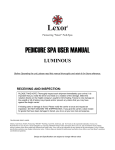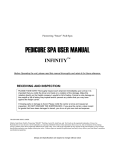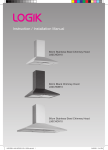Download Kenwood KDW4TTSL Dishwasher User Manual
Transcript
4 Place Settings DISHWASHER OWNER’S MANUAL MODEL: KDW4TTSL Please read this manual carefully before operating your dishwasher. Retain it for future reference. 0 Table of Contents Page Unit Parts Identification------------------------------------------------------------------------------------------------1 Important Safety Instructions-----------------------------------------------------------------------------------------2 Installation + Water Pressure ----------------------------------------------------------------------------------------3 Control Panel + LCD Display-----------------------------------------------------------------------------------------4 Loading Your Dishwasher---------------------------------------------------------------------------------------------5 Salt + Rinse Aid ---------------------------------------------------------------------------------------------------------6 Operating Instructions--------------------------------------------------------------------------------------------------7 Program Summary -----------------------------------------------------------------------------------------------------8 Common Problems and Solutions-----------------------------------------------------------------------------------9 Unit Part Identification 3 FRONT VIEW 4 5 1 6 2 7 INSIDE VIEW 8 11 9 12 REAR VIEW 13 14 15 16 17 1. Window 2. Front Panel 3. Door Release Button 4. LCD 5. Pause/Start key 6. Program key 7. Power (ON/OFF) Button 8. Rinse agent dispenser 9. Spray Arm 10. Dish Rack (Not Shown) 10a. Cutlery Basket(not shown) 11. Filter 12. Detergent location 13. Door Assembly 14. Door Latch Mechanism 15. Water inlet Connection 16. Drain Hose Connection 17. Power Cord 18. Water softener (Not Shown) 1 IMPORTANT SAFETY INSTRUCTIONS WARNING When using your dishwasher, follow basic safety precautions, including the following: Please read this manual carefully before using the dishwasher for the first time. This manual contains very important notes regarding the installation, use and maintenance of your dishwasher. The manufacturer cannot be responsible for problems caused by ignoring these safety and caution instructions. This dishwasher is designed for normal household use. Do not use the dishwasher for industrial and commercial use, or other purpose. Electrical safety is only guaranteed when the earth system of your house is in accordance with the related local regulations. (Do not use an extension cable or cord.) Only suitable household utensils should be placed in the dishwasher. (Please avoid utensils that are non-heat resistant, metal decorated, etc.) Keep detergents away from children. If the hot water exceeds 65°C, adjust the water heater setting. If the hot water temperature can not be maintained below 65°C, the dishwasher must be connected to cold water. Do not use any kinds of solvent in your dishwasher. They may cause an explosion or fire. Do not spray water on the appliance. It may cause the failure of electrical parts or electric shock. Do not allow children to operate the dishwasher. Do not allow children to play around the dishwasher when opening and closing the door. Do not push down or sit on the inner door when the door is opened. It may cause the deformation or failure of your dishwasher. Do not use the detergent for hand washing. The detergent for dishwasher should be used for normal operation. Do not open the door when the LCD display “High temperature”, the hot steam may causes personal injury. If power supply cord is damaged, it must been replaced by the manufacturer or service agent or a similar qualified person in order to avoid a hazard. This appliance is fitted with a safety function that automatically stops the operation of the dishwasher when it is exposed to heavy disturbance on its mains supply. This appliance must be positioned so that the plug is accessible. The appliance is not intended for use by young children or infirm persons without supervision. Young children should be supervised to ensure that they do not play with the appliance. Dishwasher detergents are strong alkaline. They can be extremely dangerous if swallowed. Avoid contact with skin and eyes and keep children away from the dishwasher when the door is open. Check that the detergent receptacle is empty after completion of the wash cycle. The appliance is to be connected to the water mains using new hose-sets supplied and that old hose-sets should not be re-used. 2 SAVE THESE INSTRUCTIONS WARNING Instructions pertaining to a risk of fire, electric shock, or injury to persons. Electrical Instructions: An electrical supply of 220-240 volts AC only, 50Hz is required. Make sure that a suitable electrical supply socket is located close to where the dishwasher is to be placed. For your personal safety, the appliance must be earthed. The appliance is equipped with a power supply cord having a 3-pin plug. To minimize possible shock hazards it must be plugged into a matching 3-pin type electrical outlet. If the mains plug is unsuitable for the socket outlet in your home or is removed for any other reason, then the cut off plug should be disposed of safety to prevent the hazard of electric shock. Installation Instructions 1. Remove all packing materials carefully 2. Use the supplied hose. Do not reuse old hoses. 3. The water inlet hose from the machine terminates in a ¾” female connector. The water supply should therefore terminate in a similar male connector and should have a stopcock close by in the pipe. It is recommended to connect the machine to hot water supply. Connect the straight connector of the inlet hose to the water supply securely. Connect the other end (bent connector) to the water inlet valve at the back of the dishwasher cabinet. Do not over-tighten to avoid damage to threads. 4. Prepare the drainage hose so that it has hooked end. Use the plastic U-bend fitting provided for this purpose. The end of this should be dropped into a drainage standpipe, the maximum height of which should be no more than 6” above the base of the dishwasher. To allow for an air gap around the end of the drain hose, the diameter of the standpipe should be at least 30 mm. Connect the other end of the drain hose (L shaped) to the drain port connection at the back of the dishwasher cabinet. Tighten the drain hose end on to the drain port using the metal clip included in the package. 5. If you so wish, you may connect the water inlet hose on to the kitchen sink tap. You must obtain correct fittings/adaptors to match the inlet hose connectors to ensure secure connection. However, permanent plumbing is recommended. 6. If leaks are located, immediately shut the water supply and check the hose connections fully. Tighten connections if necessary. 7. If for any reason you are unable to stop the leak yourself please seek advice from a qualified plumber. 8. The minimum height clearance required to install your dishwasher on a countertop surface with overhead cupboards is 19” (48cm). 9. Make sure there is an electrical power supply within easy reach of the machine. The power cord is 210cm long. 10. The dishwasher must be installed on a ‘firm’ level surface. 11. To level the dishwasher, adjust the 4 level screws (feet) under the dishwasher. Water Pressure For best operating results, incoming water pressure should be between 0.03~1Mpa. Incoming water supply for the dishwasher is controlled by a ‘low water switch’ application, so if household water closedown, dishwasher will stop. 3 FOR BEST RESULTS: Your dishwasher cleans by spraying a mixture of hot clean water and detergent (under pressure) against the soiled surface of dishes. The water is pumped through a rotating spray arm, drained through a filter removing food and soiled particles and pumped back through the spray arm. Soiled water is pumped out and replaced with clean water at the end of each cycle (the number of times depends on the cycle being used). For best cleaning results, the water temperature must be at least 55oC. To prevent dishwasher damage, the temperature of the incoming water supply should not exceed 70oC. NOTE: Hard Water conditions will adversely affect wash ability performance of your dishwasher. Hard Water conditions will also contribute to “Lime” (white film substance) deposits and/or “Scaling” on the stainless steel surface of the dishwasher tub and “Heater Element” located in the sump underneath the removable filter screen. To assist in minimizing these conditions, it is recommended to periodically operate/rinse the inside of the dishwasher (empty) using 1 cup of white vinegar (at least once a week). Disconnecting your Dishwasher - - Close the water supply at the stopcock. Disconnect the power supply cord. Disconnect the inlet hose assembly from the water supply. When the dishwasher is not in use, place/store the hose on the hanger hose bracket located on the rear wall of the dishwasher cabinet. Appliances that are to be discarded must be made unusable. Cut off the plug, remove cable and make the door lock and latch unusable ! IMPORTANT ! Once you open the water supply line, (even if it is closed immediately thereafter) the water inlet hose will be pressurized. ! CAUTION ! DO NOT LET CHILDREN DISCONNECT THE DISHWASHER. Close supervision of children is always important around appliances. Control panel and the LCD display 1. The power indicator will light up when the power is turned on. 2. The salt indicator will light up when it needs to be re-filled. 3. Program Key: you can select the program by pushing the program key. 4. Pause/Start key: you can start or pause the program by pushing the Pause/Start key. 4 Loading your Dishwasher - 4 Dinner Plates 4 Soup Plates 4 Dessert dish 4 Saucers 4 Cups 4 Tea spoons 1 Oval platter 1 Smal serving 1 Dish 4 Glasses 4 Soup Spoons 4 Forks 4 Knives 4 Dessert Spoons 2 Serving Spoons 1 Serving Fork 1 Gravy ladle - The dishwasher is designed to receive a standard “4 piece” plate setting consisting of the adove. NOTE: for ease of loading/unloading large size dinner plates from the dish rack it may be necessary to (temporarily) remove the cutlery basket. When loading/unloading is complete, return the cutlery basket to its original position. Preparing your Dishes for Washing - Scrape off all solid food particles from the dishes. Remove excessive quantities of oil or grease. Empty any liquids from glasses and cups. NOTE: Dishes with dried-on foods are more difficult to wash and may not come clean in a normal wash cycle. Arrange all items with recessed or curved sections on a slant to drain water away. Cups, pots, glasses, etc should be placed upside down. When loading items to be washed: Locate sharp items so that they are not likely to damage the door seal. Load sharp knives with the handles up to reduce the risk of injury. Do not load plastic items unless they are marked “dishwasher safe” or the equivalent. For plastic items not so marked, check the manufacturer’s recommendations. Do not load glasses over the dish rack pins. Glasses loaded over dish rack pins are not properly supported and are likely to get damaged. Items with wooden or bone handles and items joined together with glue are unsuitable as they cannot resist hot water. Do not touch the heating element during or immediately after use. Do not operate your dishwasher unless all enclosure panels are properly in place. Do not tamper with controls. Do not abuse, sit on, or stand on the open door or dish-rack of the dishwasher. The machine may topple over. Protect cables and hoses from high temperatures. To reduce the risk of injury, do not allow children to operate or play with the dishwasher. 5 Using the Right Detergent The recess for The detergent Use only detergent specifically made for use in dishwashers, as other types will cause over-sudding. If your detergent is old and/or lumpy, throw it away. Old detergent loses its washing power. Lumpy detergent won’t dissolve. Please put the detergent in the recess which is at the right of the inner door. How much Detergent Should You Use That depends if your water is ‘hard’ or ‘soft’. HARD WATER REQUIRES MORE DETERGENT TO GET DISHES CLEAN. SOFT WATER REQUIRES LESS DETERGENT TO GET DISHES CLEAN. The recessed detergent area located on the inside door panel will hold approximately 20 grams of detergent. Follow the detergent manufacturer’s guidelines. How to use the water softener (for models with softener) The hardness of the water varies from place to place. If hard water is used in the dishwasher, deposits will be formed on the dishes and utensils. This appliance is equipped with a water softener which uses a salt specifically designed to eliminate the minerals from the water. How to load the salt into the softener: 1. Unscrew the cap from the salt container anticlockwise, which is located on the right side of the inner box. 2. Load the salt into the container. Each time you may load 250g of salt, which can be used for 15 cycles. 3. Fill the water into the salt container until a small amount of water comes out(it is very important when you use it for the first time). 4. Screw the cap back carefully. Note: 1. Load the salt before the beginning of wash cycle so as to prevent corrosion. 2. Load the salt when the salt indicator light in the control panel is illuminated. 3. Only use dishwasher salt. Using a Rinsing Agent Add the rinse aid here You can help prevent unsightly spots on dishes and glassware, and reduce drying time by using a rinse agent. A rinse agent is specially formulated to rinse away food and detergent residues that can be left behind on your dishes. Used regularly, a rinse agent will automatically provide you with cleaner dishes every time you wash. 6 To fill the rinse agent dispenser, unscrew the dispenser cap located on the inner door (or on the back of the tub). Add the rinse agent slowly into the container until it just reaches the bottom of the filling cap inside the dispenser opening. Replace the cap. Note: Remove large particles of food sediments before placing dishes in the dishwasher. Note: The machine can be used in hot water or cold water. ! CAUTION ! Water temperatures this high can cause severe burns/scalding. Always exercise extreme care when opening and/or entering the dishwasher when the LCD display “High temperature”. Operating Instructions To operate the dishwasher: 1. Make sure the inlet and drain hoses are correctly and securely connected. 2. Push the door release button to open the door. 3. Check to make sure that the filter is in the right position. 4. Place the dishes on the dish rack and cutlery inside the cutlery basket. 5. Check to make sure that the rotating spray arm can turn freely all the way round. If necessary remove any obstacles. 6. Fill the detergent in the recessed area on inner door panel. 7. Close the door firmly 8. Open the water supply. 9. Push the power (on/off) button. -Push Button in = power on -Push Button out = power off The LCD and the power light will illuminate indicating the machine is receiving power. 10. Select the desired program by press the program key. The LCD will display the washing mode which you selected. Note: The LCD will display the default washing mode when it get the power. And if you continuously choose some washing mode for three times, this mode will be default. 11. Press the pause/start key to start. The LCD will flash the program and the washing state during operation. 12. At the end of the cycle the dishwasher will stop, the LCD will stop flash, the dishwasher will beep. The LCD will be black when the machine does not run or operate above 10 minutes. The power light remain illuminated, until the power (on/off) button is switched off. 13. The dishwasher is designed to stop if the door is opened accidentally during operation. 14. You can select another program during operation by pressing the pause/start key first, then pressing the program key to the desired program, and pressing the pause/start key to start. 15. After washing, dishes should be allowed to cool down for about 15 minutes so they are not too hot to handle. Dishes will cool quicker if the door is opened slightly. 16. After unloading the dishwasher, remove the filter, clean off any bits of food, and put the filter back in its position. NOTE: At the beginning of each cycle, the dishwasher always starts in the “drain” mode. This is because the drain pump always retains a small amount of water (in the sump) from the previous cycle. This is necessary to keep the pump primed. Therefore, do not be alarmed if you see a small amount of water being pumped-out from the drain hose prior to the start of the regular wash cycle (THIS IS NORMAL). 7 Programme Summary STRONG WASH Program Duration: Water Consumption: 130 minutes 14 litres NORMAL WASH: Program Duration: Water Consumption: 140 minutes 12 litres RAPID WASH: Program Duration: Water Consumption: 45 minutes 6 litres (Note: the washing time may vary according to the incoming water temperature) Main technical data Model Power input Outer dimension Weight Max. water Consumption Water pressure Control manner Detergent dosage Plate setting KDW4TTSL 1280W 570x480x500 About 23kg 14L 0.03~1MPa Automatic 5~20g 4 sets 35 pieces dishware ERROR CODE Your dishwasher has a error code display function, that means if the appliance falls into a certain malfunction, the corresponding error code will be shown in the displaying window. CODE E1 E2 DESCRIPTION longer inlet time longer drain time E3 longer heating time E4,E5 abnormal water level POSSIBLE CAUSE faucet is not opened the installation position of the drain pipe is too high malfunction of temperature sensor or of heating element too much inlet water 8 COMMON DISHWASHING PROBLEMS AND SOLUTIONS PROBLEM POSSIBLE CAUSE POSSIBLE SOLUTION Dishwasher will not start * Dishwasher not receiving Electrical power. * Door is unlatched. * Dishwasher not level. * Check electrical connection Fuse/circuit breaker. * Close and latch door. * Level unit. Dishes not clean * Improper loading * Arrange dishes so spray action reaches all surfaces. * Do not overload dishwasher. * Spray arm not rotating freely * Check spray arm to make sure nothing (i.e. cutlery) is obstructing spray arm rotation. * Check if filter screen has become dislodged and obstructing spray arm rotation. * Not enough detergent and/or improper detergent being used. * Use more dishwasher detergent * Do not use detergent that is old or lumpy. * Use only a recommended dishwasher detergent. * Improperly prepared dishes. * Excess food soil and liquids should be removed from dishes before loading. * Water inlet hose kinked/bent due to improper installation. * Eliminate kink or bend from Inlet hose. *The filter lose its position * Assure the filter in its right position Chipping or breaking glassware * Improper loading of dishes. * Do not overload dish rack. Load glasses on the bottom rack only, Water remains in bottom * A small amount of water (in sump area) is normal. * This is necessary to keep the pump primed and is drained automatically at the beginning of each cycle. * Excessive amount of water; cycle not completed. * Allow dishwasher to complete full cycle. This symbol on the product or in the instructions means that your electrical and electronic equipment should be disposed at the end of its life separately from your household waste. There are separate collection systems for recycling in the EU. For more information, please contact the local authority or your retailer where you purchased the product. 9 Visit Partmaster.co.uk today for the easiest way to buy electrical spares and accessories. With over 50,000 products in stock we can deliver direct to your door the very next day. Visit www.partmaster.co.uk or call 0870 6001 338 (UK customers only) Calls charged at National Rate. 10











